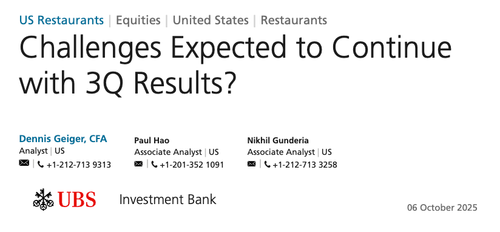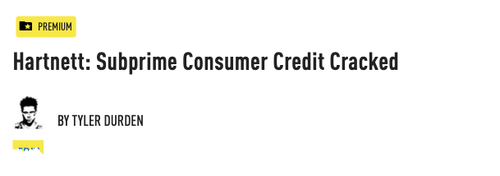First Tricolor Subprime Meltdown, Now UBS Warns: Consumer Weakness Spreading From Low-Income To Middle-Class
Restaurant spending has historically been among the first discretionary categories to decline when consumers experience economic hardship.
The picture now emerging is one of “lower-income consumer weakness spreading to at least middle-income consumers,” according to a team of UBS analysts led by Dennis Geiger.
This comes after weeks of our reporting that highlights cracks in the subprime credit markets, especially following the collapse of subprime auto lender Tricolor Holdings, and aligns with BofA’s Michael Hartnett, who recently echoed warnings about “credit cracks” emerging.
On Monday, Geiger told clients that industry data and management discussions with public and private restaurant chains suggest weaker demand trends will likely be reflected in upcoming third-quarter earnings results. Most troubling, according to the analyst, is that weakness appears to be spreading from low-income consumers to middle-income consumers, which only echoes our earlier reports of an emerging subprime crisis with low-end consumers.
Here is Geiger’s report
Industry data and mgmt discussions suggest weaker end to 3Q
Industry traffic data and our latest discussions with public & private restaurant chains suggest weaker demand trends to exit 3Q, creating risk to Consensus expectations for much of the sector. Traffic data continues to suggest a slowdown for many key brands in September, with seeming pressure on avg check often likely a result of promotional activity as well as potential customer check mgmt. Our end of quarter investor discussions with restaurant mgmt / IR teams generally highlight macro and broader industry challenges, with pressure noted across a variety of sources, often including: lower income consumer weakness which appears to be spreading to at least middle-income consumers; emergence of younger consumer spending softness; and Hispanic / immigration impacts particularly in border states. That said, several companies have appeared more confident in performance given still solid underlying demand or execution of brand specific initiatives despite the difficult macro backdrop.
Demand for value at all time high and a prerequisite in current environment
Following heightened industry value activity since mid ’24, 29% of all commercial foodservice traffic in the last 12 months was driven by deals, which is the highest rate in the last 50 years, according to a report analyzing 50 years of foodservice data from Circana. Additionally, consumer-perceived value menu traffic has increased by 2% since the beginning of ’25, while overall industry traffic has declined. Value items and promotions are key for maintaining customers, with menu innovation, service, and quality as key drivers of increasing market share. Despite the importance of value offers and perceptions, a key indicator for traffic recovery is reduced reliance on deals, with value alone not a sufficient strategy for engaging customers.
Spending at smaller restaurant chains / independents slowed in September
Consumer spending at small business restaurants increased +1.2% y/y in September, per Fiserv, slower relative to growth of +1.7% y/y in August, with foot traffic increasing +0.4% (+0.4% in August). Sales gains were largely driven by bars and pubs growth (+1.6% m/m), followed by full-service restaurants (+0.3% m/m) and QSRs (+0.1% m/m vs +2.1% m/m in Aug). Foot traffic increased slightly at full-service restaurants (+0.2% m/m), while QSR foot traffic increased 0.4% sequentially (vs +1.8% m/m in Aug), implying a ~30 bps decline in average check.
Private hospitality hiring declined in Sept; still expect moderate growth in ’25
Private leisure and hospitality hiring declined in Sept, with jobs down ~19K (vs. +10K in Aug), or down ~10 bps m/m, according to ADP employment report. As of Sept, there were ~17.6MM industry employees across leisure and hospitality, or ~1.1MM above pre-pandemic levels. Despite the sequential slowdown, industry jobs growth is still better ’25 YTD (+2.8%) than ’24 (+2.4%), and we continue to expect a modest job growth in ’25.
Investor concern w/ slowing traffic trends, with focus on headwinds & outlook
Our investor discussions last week continued to highlight concerns around slowing industry demand trends and factors contributing to the traffic pressure, as well as the outlook for what could change into ’26. Investors continue to view the restaurant sector as challenging and struggle to identify compelling long opportunities, while at the same time maintaining caution around potential shorts that could snap back. Fast casual remains the segment with the most investor attention as investors see potentially significant upside for several faster growth names if trends positively inflect. Investors are also focused on which names are best to own, with the most torque, on an eventual broader recovery in industry sales trends (WING, CMG often at the top of the list). Investors are also increasingly focused on expectations into 3Q earnings, with questions around what to own into results given a large percentage of the sector is expected to miss given recent weakness. Concerns continue around slower alt data trends in September, with the recent trajectory for many brands suggesting an early read into 4Q that Consensus expectations could prove too high.
Here is where the first cracks began to appear in the consumer credit market:
- Subprime Crisis 2.0? Red Flags Fly As Alleged Fraud Triggers Billion-Dollar Auto-Lender Bankruptcy
- “Worst Thing I’ve Ever Seen”; Trickle-Down Terror Of Tricolor Trouble Hits Alts
Then last Thursday, BofA’s Michael Hartnett chimed in where we left off, and penned in the Zeitgeist section (read here) that “these credit cracks are a big deal, but not big enough to put top in right now.“
And remember what Goldman’s top consumer analyst wrote at the end of last month…
These emerging cracks in the consumer space are alarming, given that personal consumption expenditures account for 68% to 70% of U.S. GDP. Time for deeper interest rate cuts, Mr. Powell?
Tyler Durden
Mon, 10/06/2025 – 12:35ZeroHedge NewsRead More








 T1
T1


